Unauthorized Passengers in Cargo Transportation: Risks and Considerations

This post is part of a series sponsored by IAT Insurance Group.
In 2019, a woman died after a semi-truck hauling avocados swerved and struck a parked vehicle, attempting to avoid a road rage incident. The deceased woman was the truck driver’s wife — an unauthorized passenger in the semi at the time of the accident. The truck driver’s company paid $960,000 from its $1 million auto liability insurance line for her death. Because there was no other insurance such as a specific passenger insurance policy, the auto liability policy was exhausted to cover damages to other parties involved in the accident, including passengers.
This scenario can happen to any motor carrier — and carries serious financial repercussions. A standard auto liability insurance policy with limits of $1 million often is insufficient to compensate for the loss of life and associated expenses — especially when surviving family members or other victims pursue legal action against the driver or trucking company.
The U.S. Department of Transportation prohibits commercial truck drivers from transporting passengers without explicit written authorization from their motor carriers.[1] Exceptions apply to employees and other authorized workers, people rendering aid in an emergency and attendants delegated to care for livestock.
Unknowingly and knowingly, truck drivers violate this rule by bringing their spouses or other unauthorized individuals with them without obtaining permission or following established guidelines. Part of the reason? A rising number of motor carriers lack adequate policies and procedures for commercial vehicle passengers. If your business is among them, you’re carrying a great deal of additional risk.
4 considerations for establishing passenger-specific procedures
The right approach to managing passengers can help your business survive unexpected events involving non-employee riders. Before allowing passengers to ride with commercial truck drivers, establish passenger-specific procedures and include that information in your driver handbook. Here are four considerations for doing so.
1. Driver considerations
Review your drivers’ MVR. Have they been involved in accidents? Received traffic tickets? To minimize risk, drivers should only be allowed to carry non-employee passengers if they have no history of moving violations, log violations, preventable accidents or roadside inspection violations in the last 36 months.
Tenure and overall experience should also play into your policy. It’s recommended that drivers have at least one year of employment with your company before they’re allowed to transport passengers. Additionally, they should have at least two years of industry experience or 200,000 miles of driving experience before taking non-employee passengers.
2. Passenger considerations
Certain types of passengers carry more risk than others. Consider implementing restrictions for the following:
Minors. Death or injury claims involving victims under age 18 often result in costlier damages due to the projected life span and impact on the life of a minor. It can be difficult to determine the total cost of the accident’s impact on future contributions and accomplishments, so settlements tend to be higher. There’s also a greater potential for minors to engage in dangerous behavior that could increase the risk of an accident.
Non-family passengers. Friends and strangers (such as hitchhikers or clients who need a ride home) may be less invested in your driver’s success on the road than family. While these types of passengers are uncommon, it’s best to be clear and recommended to limit passengers to family members only.
3. Legal considerations
While a no-passenger policy is preferred, if you choose to allow passengers, have them sign a “hold harmless” agreement and have a separate passenger policy with adequate limits in place before hitting the road. A hold harmless agreement states that the driver and company are not responsible for any injuries or losses the passenger sustains when in or around the truck. While a hold harmless policy may not always hold up in a court of law depending on the extent of the injuries or in death, having a separate passenger policy helps mitigate damages.
You’ll also want to prohibit passengers during inclement weather or seasons that pose a higher risk of accidents, such as the winter months.
Additionally, your driver handbook should clearly outline the procedure for drivers to get manager approval and written permission before bringing passengers into the truck.
4. Insurance considerations
Passengers in commercial vehicles increases the potential for a large loss, which may increase insurance premiums. Insurance companies may increase premiums or ask you to obtain a passenger insurance policy if you allow passengers in commercial vehicles.
While drivers usually have workers’ compensation or occupational accident insurance protection in case of accident injuries, injured passengers may seek remedy from your auto liability policy if no other insurance, such as a passenger insurance policy exists.
Distinguish between casual labor and non-employee passengers
Be sure to note the difference between casual labor and non-employee passengers. This is particularly relevant for moving and storage companies that often have casual laborers ride with truckers.
Non-employee passengersare transported in a vehicle but are not employees of the company operating the vehicle, such as family, friends, clients and hitchhikers.
Casual laborers are workers who perform various services on a temporary or part-time basis. Casual laborers may increase the commercial auto liability loss exposure if they are not covered by other insurance such as workers compensation or occupational accident insurance. It is important to discuss with your insurance agent all insurance options to ensure you are adequately protected when transporting casual labors in commercial vehicles.
Ask a loss control representative
Have a question on how to mitigate risk? Email losscontroldirect@iatinsurance.com for a chance to see your question answered in a future blog.
By Jaden Tareta
[1] Department of Transportation National Archives Code of Federal Regulations “§ 392.60 Unauthorized persons not to be transported,” July 28, 1995.
Topics
Trucking
Interested in Trucking?
Get automatic alerts for this topic.





